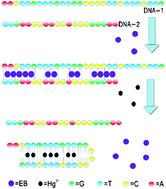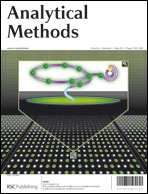An oligonucleotide-based label-free fluorescent sensor: highly sensitive and selective detection of Hg2+ in aqueous samples
Abstract
A highly sensitive and selective detection method for mercury(II) in aqueous samples was developed based on the use of an oligonucleotide-based label-free fluorescent probe. The novel design was composed of two oligonucleotides with partially complementary sequences and the label-free dye ethidium bromide (EB). The fluorescence signal was very low when EB was free in water solution. However, the fluorescence signal increased by nearly 15 times when the DNA duplex was present. This dsDNA–EB system was used as a fluorescent sensor for Hg2+. The presence of Hg2+ led to the release of EB from the grooves of dsDNA and the fluorescence intensity was quenched. In this investigation, the optimal concentrations of dsDNA and EB were 0.285 μM and 0.9 μM, respectively. The calibration curve was linear in the range of 30 to 120 nM for Hg2+ (R2 = 0.992), with a detection limit of 9.5 nM. The method was simple and convenient, and this sensor also provided potential applications for developing aptasensors.


 Please wait while we load your content...
Please wait while we load your content...